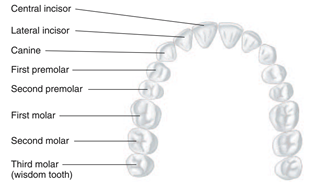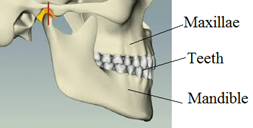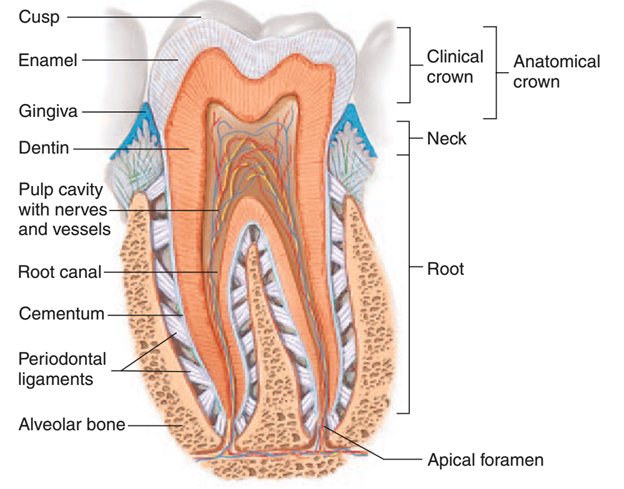Science > Biology > Digestion and absorption in Human > Buccal cavity – Teeth
In this article we shall study, the characteristics of teeth (dentition), different types of teeth and the structure of the tooth.
The teeth are the strongest, hardest and rigid substances in the human body specialized for the biting and grinding of food (known as mastication, or chewing). They form a continuous row in the bottom of the mouth surrounding the tongue on the lateral and anterior sides, as well as another nearly identical row extending from the roof of the mouth. Teeth form deep roots into the bones of the maxillae and the mandible but grow out through the gums of the mouth to form biting surfaces. Normal adults have 32 teeth, which are distributed in two dental arches. One is called the maxillary arch and the other is called the mandibular arch.
Man is provided with two sets of teeth, which make their appearance at different periods of life. Those of the first set appears in childhood and are called the deciduous or milk teeth. Those of the second set, which also appear at an early period, may continue until old age and are named permanent. The deciduous teeth are twenty in number: four incisors, two canines, and four molars, in each jaw. The permanent teeth are thirty-two in number: four incisors, two canines, four premolars, and six molars, in each jaw. The third molars are called wisdom teeth because they usually appear in a person’s late teens or early twenties when the person is old enough to have acquired some wisdom.

Characteristics of Teeth:
The Condont Dentition:
It is an arrangement in which the base of the tooth is completely enclosed in a deep socket of bone is the characteristic of mammalian teeth as seen in humans, loins, goats, etc. this arrangement makes the attachment strongest in the vertebrates. Such teeth are embedded in pits of maxillae in upper jaw and mandibles in the lower jaw. These pits are called sockets or alveoli. The animals having a condont dentition cannot lose their teeth easily as compared to Acrodont, where teeth are attached on the top surface of the jaw bone as in fish and amphibians. Acrodont type of attachment is not very strong and teeth are lost easily and are replaced by new ones.

Diphyodont Dentition:
Human teeth are diphyodont because these are formed in two sets. It is a characteristic of mammals in which milk teeth (first set) appear in the young ones but as they grow and jaw becomes larger, milk teeth are replaced by larger permanent ones (second set) to fit in the larger jaw bone.
Primary Dentition:
There are 20 primary or deciduous teeth in children. In general, the order of eruption is two lower central incisors, 6 to 8 months; two upper central incisors, 5 to 7 months; two lower lateral incisors, 8 to 11 months; two upper lateral incisors, 7 to 10 months; four canines (cuspids), lower and upper, 16 to 20 months; four first molars, lower and upper, 10 to 16 months; four second molars, upper and lower, 20 to 30 months. Thus eruption of primary sets of teeth is completed by the age of 2.5 years.

The dental formula which is a representation of the number of teeth in either half of upper and lower jaws for primary dentition is
i 2/2, c 1/1, pm 0/0, m 2/2
i.e. total (2 + 2 + 1 + 1 + 0 + 0 + 2 + 2 = 10) x 2 halves = 20 teeth
Secondary Dentition:
The secondary or permanent teeth, which begin to erupt at about 6 years of age in people. These are completed by the 16th year with the exception of third molars, which appear between the 18th and 25th years. In some individuals the third molars, although present beneath the gingiva, do not erupt. There are 32 teeth in the permanent set. The dental formula for secondary dentition is
i 2/2, c 1/1, pm 2/2, m 3/3
i.e. total (2 + 2 + 1 + 1 + 2 + 2 + 3 + 3 = 16) x 2 halves = 32 teeth
Heterodont dentition:
Due to Heterodont dentition, humans have different shapes of teeth to carry different functions. There are 4 functionally different types of teeth, namely, flat incisors, canines, premolars, and molars. Pre-molars have no counterparts in the milk teeth.

Incisors:
Incisors are front teeth, which are flat and chisel-shaped. These have sharp cutting edges for cutting, chopping, and gnawing. They have a single root. In an elephant, incisors grow out into tusks and are not used for biting or cutting.
Canines:
Canines are more pointed and cone-shaped or dagger-shaped. They have a single root. They are used for ripping and sheading. In carnivorous animals, they are long and prominent. They are usually absent in herbivorous animals. In walrus upper canines grow out into tusks.
Premolars and Molars:
Premolars and molars are broad and have flat surfaces. These are used for shearing, crushing and grinding. They are also called grinding teeth. They have two roots. There are third molars called wisdom teeth. Some persons do not get them or get removed for a faulty eruption. In herbivorous animals, premolars and molars are broad and high cusps for eating and chewing grass. In carnivorous they have sharp cusps for shearing flesh.
Structure of a tooth:
The tooth is placed in a socket or alveolus (plural: alveoli) over the jaw bone. It is distinguished into three parts: root, Neck, and Crown. Each tooth consists of a crown with one or more tips (cusps), a neck, and a root. The clinical crown is that part of the tooth exposed in the oral cavity. The anatomical crown is the entire enamel-covered part of the tooth.

Root:
The root is the basal part of the tooth that extends into the bone and holds the tooth in place. It makes up approximately two-thirds of the tooth. It’s made up of following parts:
- Root canal: The root canal is a passageway that contains pulp. It provides a passageway for the nerves and blood vessels.
- Cementum: it is also called cement. It is a hard connective tissue that covers a tooth’s root. It is connected to the periodontal ligament.
- Periodontal ligament: It is made up of collagenous connective tissue fibers by which a tooth’s root is connected to its socket. It contains both nerves and blood vessels. Along with the cementum.
- Nerves and blood vessels: Blood vessels supply the periodontal ligament with nutrients, while nerves help control the amount of force used when you chew.
- Jaw bone. The jaw bone is also called the alveolar bone. It encompasses the roots of the teeth and holds the teeth in place.
Neck:
It is also called the dental cervix, which sits between the crown and root. It is part above the root and enclosed in a soft, fleshy gum or gingiva. It forms the line where the cementum (that covers the root) meets the enamel. It has three main parts:
- Gums: They are also called gingiva, are the fleshy, pink connective tissue that’s attached to the neck of the tooth and the cementum. Teeth are housed in gums. Gums protect a tooth’s roots and any teeth that have yet to erupt.
- Pulp: The pulp is the innermost portion of the tooth that houses the blood vessels, nerves, and connective tissue. This region is sensitive to pain. The nerves and blood vessels of the tooth enter and exit the pulp through a hole at the point of each root called the apical foramen.
- Pulp cavity: The pulp cavity, sometimes called the pulp chamber, is a central space bounded by a layer of odontoblast cells and filled with soft pulp.
Crown:
This is the top, visible part of a tooth. It contains three parts:
- Anatomical crown. This is the top portion of a tooth. It’s usually the only part of a tooth that we can see.
- Enamel: This is the outermost layer of a tooth. It covers and protects all teeth. It is the hardest substance in the human body. It helps to protect teeth from bacteria. It also provides strength so the teeth can withstand pressure from chewing. Since it doesn’t regenerate, preventing tooth decay is critical to keep the enamel intact.
- Dentin: This layer is located beneath the enamel and cementum. Chemically it is similar to bone. It extends from the crown down through the neck and root. Microscopic tubules that allow various food types access to nerves are enclosed here. It protects teeth from heat and cold. When enamel is worn away from a tooth, the dentin becomes vulnerable to sensitivity.
Previous Topic: Human Digestive System: Buccal Cavity: Mouth
Science > Biology > Digestion and absorption in Human > Buccal cavity – Teeth
